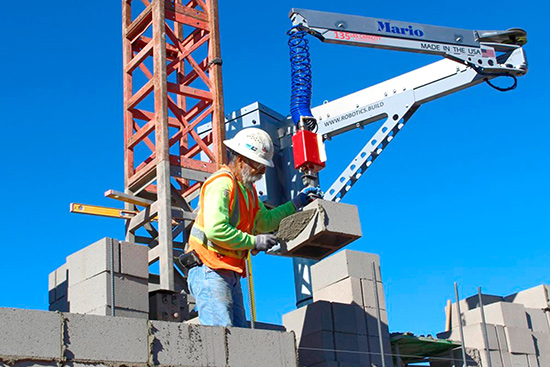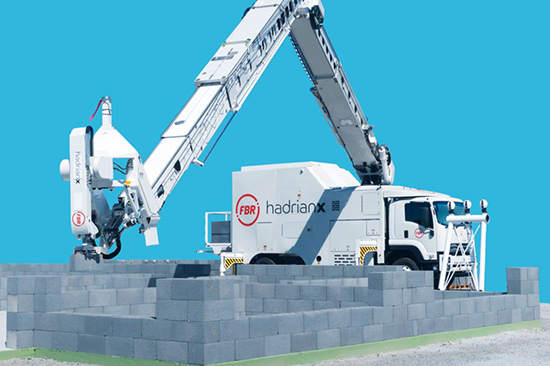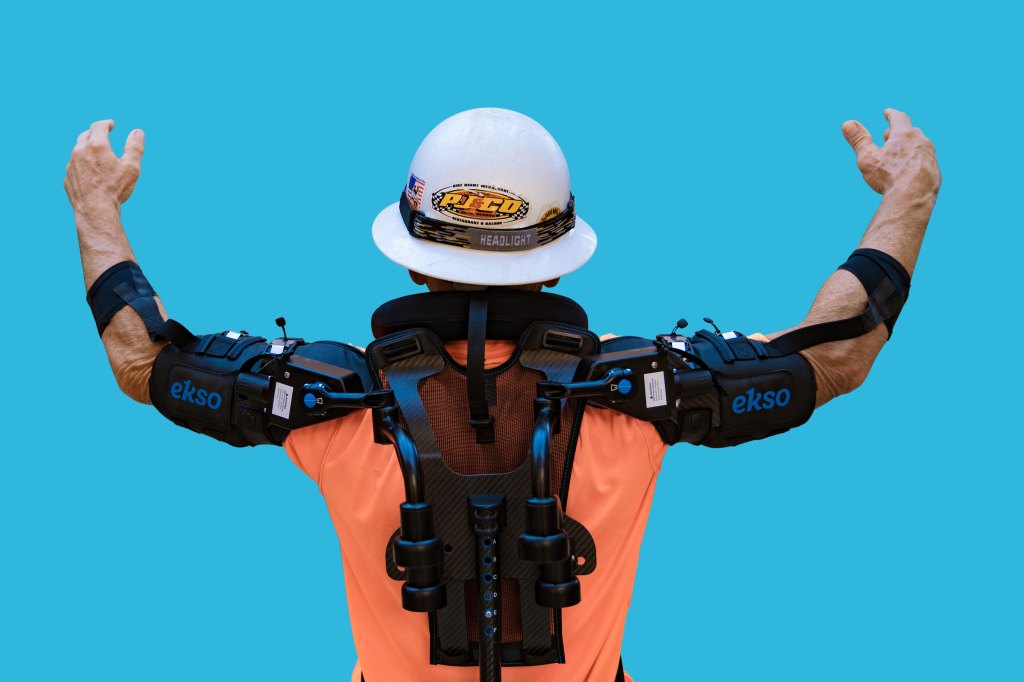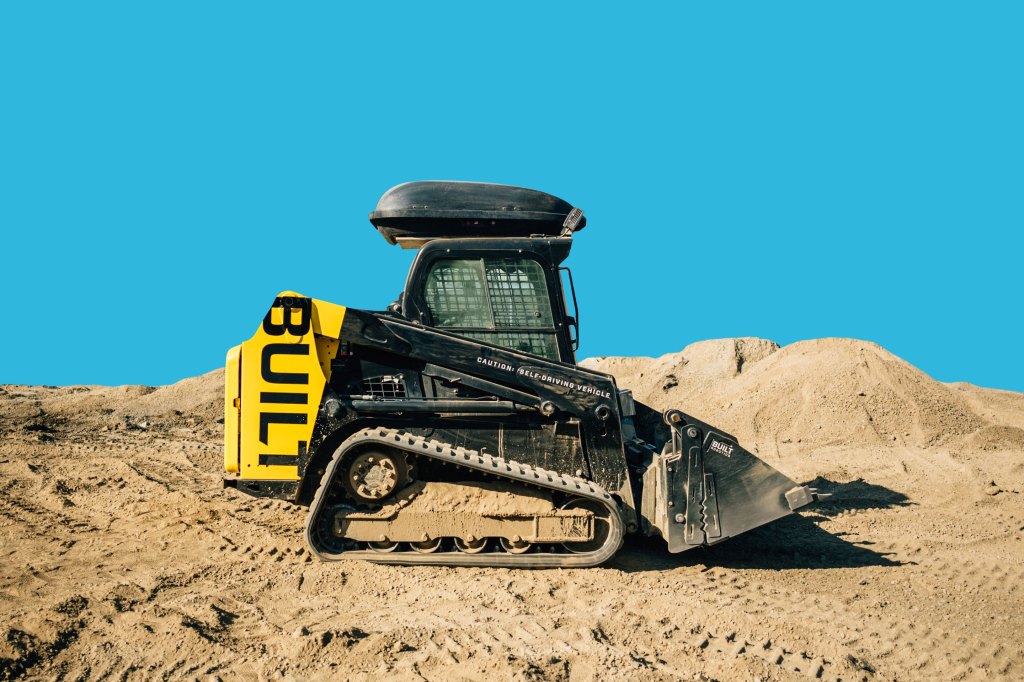機(jī)器人正在改變建筑行業(yè)

|
在密歇根湖畔,,20名泥瓦匠正在伊利諾伊州的大湖區(qū)海軍基地修建一座巨大的宿舍,,面積有三個足球場那么大。和前些年相比,,這些泥瓦匠做的鋪砌和“抹油”工作要少得多了,,相反,他們的重點(diǎn)變成了質(zhì)量控制和清理灰漿接縫,。 一個名叫SAM的機(jī)器人承擔(dān)了真正的重體力勞動,。 SAM的外形就像從籠子里伸出的一只金屬爪子,沿墻來回移動,,每8至12秒砌一塊磚,。它的旁邊是另一個有著3.6米長機(jī)械臂的機(jī)器人MULE,能夠輕松地舉起沉重的混凝土砌塊并在工人的引導(dǎo)下將其放到位,。 這兩個機(jī)器人可從早忙到晚,,從不請病假,也不會累,。負(fù)責(zé)海軍項(xiàng)目的大型通用承包商Clark Construction公司的高級項(xiàng)目經(jīng)理泰勒·肖克羅斯表示:“說到底就是可靠性以及完成這項(xiàng)工作的確定性,。” 如今,,可靠性是建筑業(yè)的大問題,,而全球每年的建筑開支已經(jīng)接近10萬億美元。咨詢公司麥肯錫的數(shù)據(jù)顯示,,絕大多數(shù)的大型工程項(xiàng)目都會超支,,耗時也比預(yù)期長20%。 造成這個問題的部分原因是勞動力短缺,。軟件公司歐特克和美國通用承包商協(xié)會(Associated General Contractors of America)進(jìn)行的調(diào)查顯示,,今年8月,建筑行業(yè)有710萬個空缺職位,,而且有80%的建筑公司表示很難招到人,。 建筑工作,,無論是修橋、鋪路還是蓋房子,,都是臟活累活,,而且很危險(xiǎn)。美國勞工統(tǒng)計(jì)局的數(shù)據(jù)表明,,建筑業(yè)是工作場所傷亡最多的行業(yè)之一,,2017年,有965名建筑工人在工地喪生,。 投資者認(rèn)為技術(shù)可以消除建筑業(yè)的一些不利因素,。去年,他們向科技初創(chuàng)公司投入了31億美元,,這些公司的業(yè)務(wù)覆蓋了建筑業(yè)的方方面面,,從排班軟件到預(yù)制房屋工廠,再到SAM這樣的機(jī)器人,。 Construction Robotics公司的總部設(shè)在紐約州維克托鎮(zhèn),,是機(jī)器人SAM和MULE的制造商。該公司的聯(lián)合創(chuàng)始人斯科特·彼得斯說:“過去三年,,情況有了很大的改變?!?/p> 但利潤率低,、風(fēng)險(xiǎn)高而且工期緊張的建筑業(yè)是出了名的謹(jǐn)慎。要使用新技術(shù),,承包商就得重新考慮開展工作的方式,,而這會增加成本和風(fēng)險(xiǎn)。 麥肯錫的一位合伙人何塞路易斯·布蘭卡說:“如果發(fā)生事故,,誰來承擔(dān)責(zé)任,?沒有人想第一個出問題?!?/p> 當(dāng)然,,對機(jī)器人應(yīng)用的推動仍然處于初期階段。雖然某些種類的建筑工作已經(jīng)可以使用這項(xiàng)技術(shù),,但精細(xì)度要求更高的電工和木工還不行,。價(jià)格是另外一個主要絆腳石。比如,,Construction Robotics公司的機(jī)器人售價(jià)為7.5萬美元到50萬美元,。 彼得斯說,即使建筑公司的高管青睞新技術(shù),,但讓所有人,,包括工頭和一線工人在內(nèi)都這么想可能很困難,。以泥瓦匠為例,2015年,,砌磚機(jī)器人SAM在一次展銷會上首次露面時他們有一些顧慮,,因?yàn)椴糠帜嗤呓硴?dān)心失去工作。彼得斯說:“有些人超級興奮,,還有一些人卻嚇的要死,。” 美國和加拿大手工工人行業(yè)組織 “國際砌磚工人和相關(guān)工藝工人聯(lián)合會”(International Union of Bricklayers and Allied Craftworkers)對MULE的態(tài)度較為熱情,。MULE的機(jī)械臂可以迅速舉起不超過135磅(約65.3千克)的工具,、石塊和混凝土板,從而讓工人不再受體力的限制,。 該組織的職業(yè)培訓(xùn)部門國家負(fù)責(zé)人鮑勃·阿諾德說:“對SAM的態(tài)度略有不同,,因?yàn)楣と藗冇X得它正在取代他們,從某種角度來說,,有這種可能,。” 盡管人們感覺各異,,但國際砌磚工人和相關(guān)工藝工人聯(lián)合會已經(jīng)開始培訓(xùn)它的成員使用這些機(jī)器,。三年來,Construction Robotics公司的技術(shù)已經(jīng)在三個國家的165處建筑工地上得到了應(yīng)用,。 其他公司也想讓自己的建筑型機(jī)器人變成熱門產(chǎn)品,。澳大利亞公司FBR制造的Hadrian X可以在一天內(nèi)建起一座完整住宅的墻壁,所用的磚塊尺寸是傳統(tǒng)磚塊的12倍,。同時,,紐約公司Toggle推出的5英尺(約1.5米)高機(jī)器人可以舉起沉重的混凝土工程鋼筋并進(jìn)行處理,工人只需負(fù)責(zé)最后的施工步驟,。 一批位于舊金山灣區(qū)的初創(chuàng)公司也在采取行動,。Doxel制造的自動化機(jī)器人和無人機(jī)擁有三維視覺和人工智能,可以在工地行走或飛行,,檢查管道施工進(jìn)度以及是否存在缺陷,。Ekso Bionics制造的機(jī)械外骨骼可以在頭頂鉆孔或安裝管道這樣的工作中支撐工人的胳膊,該公司的另一種機(jī)械臂能夠幫助工人更輕松地使用沉重工具,,從而減少疲勞和受傷的情況,。Dusty Robotics制造的小型自動化機(jī)器人可以在建筑工地四處移動,并且按照圖紙?jiān)诨炷翗敲嫔蠘?biāo)出墻壁和基礎(chǔ)設(shè)施的位置,。 很少有公司像舊金山初創(chuàng)企業(yè)Built Robotics那樣嘗試“大目標(biāo)”,。這家公司為推土機(jī)等重型設(shè)備提供自動化技術(shù)。比如,,它的技術(shù)可以讓卡特彼勒的牽引車移走土方或者舉起木制托架,,而且不需要任何人工干預(yù),。 |
Along the banks of Lake Michigan, 20 masons lay bricks for a huge dorm, as big as three football fields, at the Naval Station Great Lakes in Illinois. Compared with those in years past, these workers are doing far less laying and “buttering” and, instead, are focused on quality and on cleaning up mortar joints. A robot named SAM handles the real grunt work. SAM, a clawlike metal arm extending from a cage, moves back and forth along the walls, buttering and layering a brick every eight to 12 seconds. Nearby, another robot called MULE uses a burly 12-foot arm to lift heavy cement blocks for workers, who then guide them into place. Neither bot takes sick days or gets sore muscles, and both can work around the clock. “It’s all about reliability and certainty that the job will get done,” says Tyler Shawcross, senior project manager at Clark Construction, the general contracting giant co-overseeing the Navy project. These days, reliability is a big issue in the construction industry, responsible for nearly $10 trillion in global spending annually. The vast majority of large construction projects go over budget and take 20% longer than expected, according to consulting firm McKinsey. The problem is partly owing to a labor shortage. In August, 7.1 million construction jobs went unfilled, and 80% of construction companies say they struggle to recruit and hire people, according to a survey by software firm Autodesk and Associated General Contractors of America. Construction work—whether building bridges, roads, or homes—is dirty, physical, and dangerous. The sector is among the leaders in workplace fatalities, with 965 job-site deaths in 2017, according to the U.S. Bureau of Labor Statistics. Investors think technology can fix some of the construction industry’s downsides. Last year they pumped $3.1 billion into tech startups focused on everything from construction-scheduling software to factories that churn out prefab housing to robots like SAM. “In the last three years, there’s been a big transformation,” says Scott Peters, cofounder of Construction Robotics, based in Victor, N.Y., and maker of the SAM and MULE robots. “Most people understand change is needed.” But with low profit margins, high risk, and tight timelines, the construction industry is notoriously cautious. Adding new technology requires contractors to rethink how they do their work, and that adds to the cost and risk. “If there’s an accident, who is at fault?” says Jose Luis Blanco, a partner at McKinsey. “No one wants to be the first one when it goes south.” The push to use robots is, of course, still in its early days. Although the technology exists for certain kinds of construction work, it isn’t there for electrical work and carpentry, which require more finesse. Price is also a major stumbling block. The robots sold by Construction Robotics, for example, cost $75,000 to $500,000. Even if construction executives favor new technologies, getting everyone else on board, from foremen to frontline workers, can be difficult, says Peters. Masons, for instance, had some misgivings about the SAM bricklaying robot when it was unveiled at a trade show in 2015 because some of them feared losing their jobs. “You got some people who were super excited and other people who were scared to death,” Peters says. MULE has had a warmer welcome from the International Union of Bricklayers and Allied Craftworkers. Its robotic arm can quickly lift tools, stones, and concrete panels of up to 135 pounds, eliminating physical strain on human workers. “SAM is a little bit different,” says Bob Arnold, the national director of the union’s arm responsible for job training, “because they feel that it’s replacing them, and, in a way, it could.” Despite those mixed feelings, the union started training its members to use the machines. Over the past three years, Construction Robotics has deployed its technology on 165 job sites in three countries. Other companies are also trying to gain traction with their construction-focused robots. Hadrian X, by FBR in Australia, builds walls for a complete home in a single day using bricks that are 12 times as large as traditional ones. Meanwhile, Toggle, in New York, makes five-foot-tall robots that can lift heavy steel rebar used in concrete construction and manipulate it, while humans handle the final touches. A host of Bay Area startups are also getting in on the act. Doxel builds autonomous robots and drones with 3D vision and artificial intelligence that roll around and fly over job sites, inspecting how much plumbing work has been done and whether it was done correctly. Ekso Bionics makes robotic vests that support a worker’s arms for jobs like drilling or installing piping overhead. It also sells a robotic arm that makes it easier for workers to use heavy tools, reducing fatigue and injury. And Dusty Robotics makes small autonomous bots that roll around construction sites and mark lines on concrete floors that indicate the location of walls and infrastructure, based on construction documents. Few companies are trying anything as ambitious as San Francisco startup Built Robotics. It sells autonomous technology for bulldozers and other heavy equipment. The tech can enable a Caterpillar tractor, among others, to move dirt and lift pallets of wood—all without anyone in the cab. |

|
那些“大腦”,,也就是傳感器、人工智能和攝像頭的組合,,安裝在工程機(jī)械駕駛室上方,,看起來就像轎車的行李架。軟件工程師必須和承包商合作,,針對具體工作編寫自動化引導(dǎo)程序,,承包商則按月為這樣的技術(shù)付費(fèi)。 Geofences可以告訴計(jì)算機(jī)工地的邊界在哪里,,它和遠(yuǎn)程切斷按鈕一起防止工程機(jī)械出問題,。在分析其工作的機(jī)器學(xué)習(xí)軟件幫助下,這些工程機(jī)械應(yīng)該可以逐漸變得聰明起來,。 大型承包商Mortenson把Built Robotics公司的自動化技術(shù)用在了牽引車上,,而這些機(jī)械正在得克薩斯、堪薩斯以及科羅拉多東部農(nóng)村地區(qū)的五座風(fēng)電場移動土方并修筑道路,。Mortenson的副總裁埃里克·塞爾曼說,,這些風(fēng)電場的面積都達(dá)到或超過了100平方英里(約259平方千米),是測試此類新技術(shù)的理想場所,。 他說:“這些機(jī)器人正在變得越來越好,,越來越聰明,而且越來越快,。” 塞爾曼認(rèn)為,,此項(xiàng)技術(shù)讓建筑工作變得更安全,,因?yàn)樗尳ㄖと诉h(yuǎn)離危險(xiǎn),而且可以把精力集中在其他工作上,,比如規(guī)劃,。他們還會承擔(dān)監(jiān)督推土機(jī)工作的任務(wù),而且經(jīng)常會同時管理好幾臺推土機(jī),,隨后還要檢驗(yàn)這些推土機(jī)的工作質(zhì)量,。 塞爾曼希望機(jī)器人最終能夠成為幫助他們招聘的工具,可以鼓勵更多的年輕人從事建筑工作,。 他說:“還沒有任何機(jī)器人如何作業(yè)或者人們怎樣與機(jī)器人合作的手冊,。但我們知道我們現(xiàn)在就需要開始教他們這些技能,以便為今后不同的而且是更聰明的工作方式做好準(zhǔn)備,?!?/p> |
The “brains”—a combination of sensors, intelligence, and cameras—are affixed atop the vehicle’s cab inside what looks like a car luggage carrier. Software engineers must work with on-site contractors, who pay a monthly fee for the technology, to program the autonomous guidance system for specific jobs. Geofences—which tell the computer the physical boundaries of a job site—and remote kill buttons keep the vehicles from going awry. Over time, with the help of machine learning that analyzes their work, the vehicles are supposed to get smarter. Mortenson, a large contracting firm, is using Built’s autonomous technology on tractors that move dirt and build roads at five wind farms in rural Texas, Kansas, and eastern Colorado. Covering 100 square miles or more, the wind farms are ideal places for testing such new technology, says Eric Sellman, a Mortenson vice president. “The robots keep getting better and better, and smarter and faster,” he says. This technology, Sellman says, makes job sites safer by letting construction crews stay clear of danger while they focus on other tasks, such as planning. Workers are also assigned to oversee the bulldozers, often monitoring several machines at once, and then verifying whether they’ve done a good job. Sellman hopes that robots will ultimately become a recruiting tool, encouraging more young people to pursue careers in construction. “There isn’t any rule book yet on how robots and people will work together,” Sellman says. “But we know we need to start teaching our people the skills now to prepare for a future where we work differently and work smarter.” |
****
?
|
在建筑業(yè)站穩(wěn)腳跟的機(jī)器人 初創(chuàng)公司正在設(shè)法讓建筑業(yè)中的各種工作實(shí)現(xiàn)自動化,。以下是一些實(shí)例。 |
Robots Cement Their Place in Construction Startups are working to automate different jobs within the building industry. Here are a few examples. |

|
FBR 該公司的Hadrian X機(jī)器人擁有安裝在卡車上的機(jī)械臂,,它砌墻的速度比人快,,使用的磚塊尺寸是傳統(tǒng)磚塊的12倍。 |
FBR This company’s Hadrian X robot has a mechanical arm mounted on a truck that builds walls faster than humans, with bricks that are 12 times as big as traditional ones. |

|
EkSo Bionics 該公司的外骨骼支撐著工人的胳膊和后背,,為他們提供超級英雄般的力量,,從而減少疲勞和受傷情況。它的另一種機(jī)械臂則讓沉重的工具看起來輕如鴻毛,。 |
EkSo Bionics Its vest supports workers’ arms and backs to provide superhero strength, reducing fatigue and injury. A separate robotic arm makes heavy tools seem weightless. |

|
Built Robotics 一套由攝像頭,、GPS、傳感器和人工智能組成的系統(tǒng)讓推土機(jī)等重型工程機(jī)械實(shí)現(xiàn)自動作業(yè),,可以在沒有人員操作的情況下進(jìn)行土方挖掘,。(財(cái)富中文網(wǎng)) 本文另一版本登載于《財(cái)富》雜志2019年12月刊,標(biāo)題為《投身建筑業(yè)的機(jī)器人》,。 譯者:Charlie 審校:夏林 |
Built Robotics A system of cameras, GPS, sensors, and A.I. turns bulldozers and other heavy equipment into autonomous vehicles that can dig without human operators. A version of this article appears in the December 2019 issue of Fortune with the headline “Bots Start Building.” |













